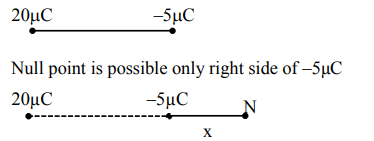Question:
Two particles A and B having charges $20 \mu \mathrm{C}$ and $-5 \mu \mathrm{C}$ respectively are held fixed with a separation of $5 \mathrm{~cm}$. At what position a third charged particle should be placed so that it does not experience a net electric force?

Correct Option: , 2
Solution:

$\mathrm{E}_{\mathrm{N}}=+\frac{\mathrm{k}(-5 \mu \mathrm{C})}{\mathrm{x}^{2}}+\frac{\mathrm{k}(20 \mu \mathrm{C})}{(5+\mathrm{x})^{2}}=0$
$x=5 \mathrm{~cm}$
$\therefore$ option (2) is correct
Click here to get exam-ready with eSaral
For making your preparation journey smoother of JEE, NEET and Class 8 to 10, grab our app now.
